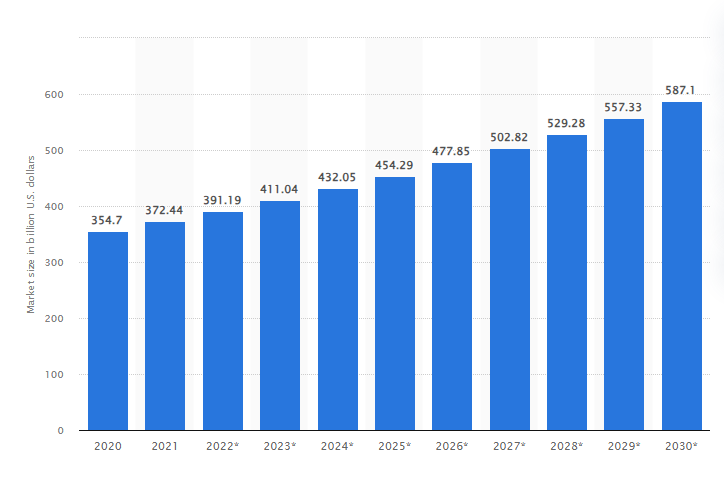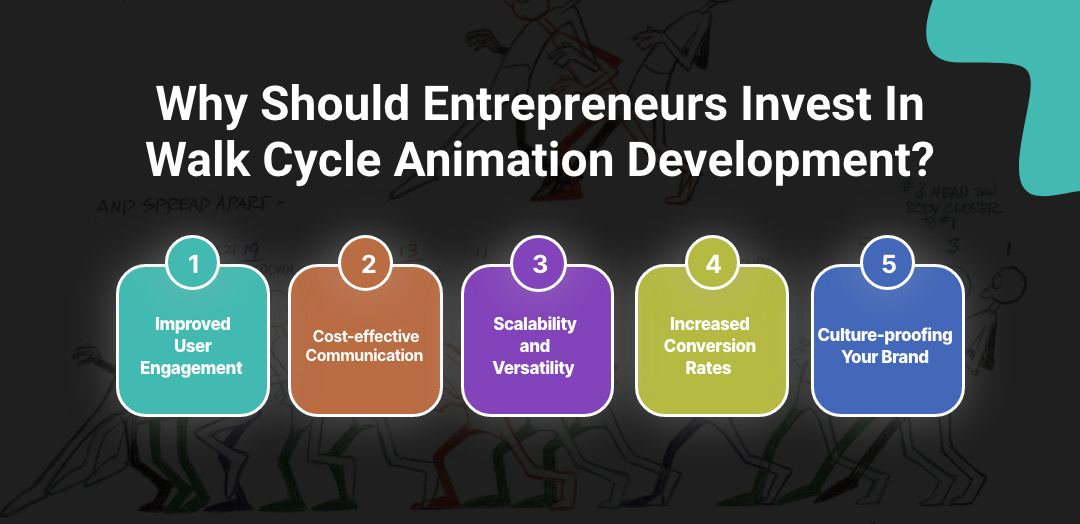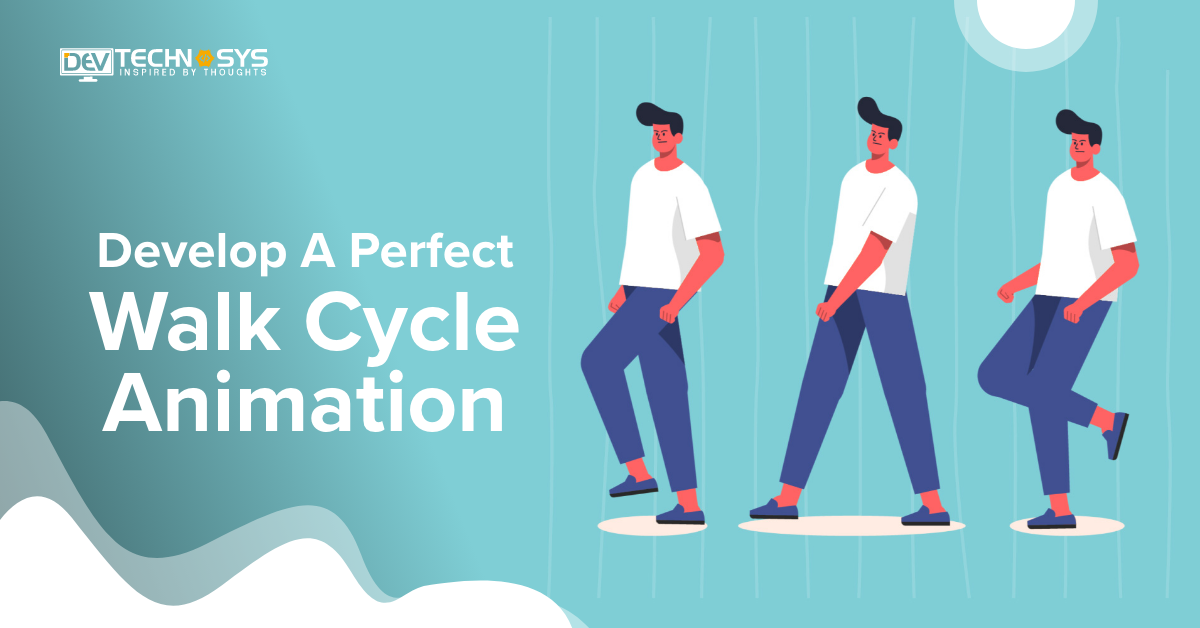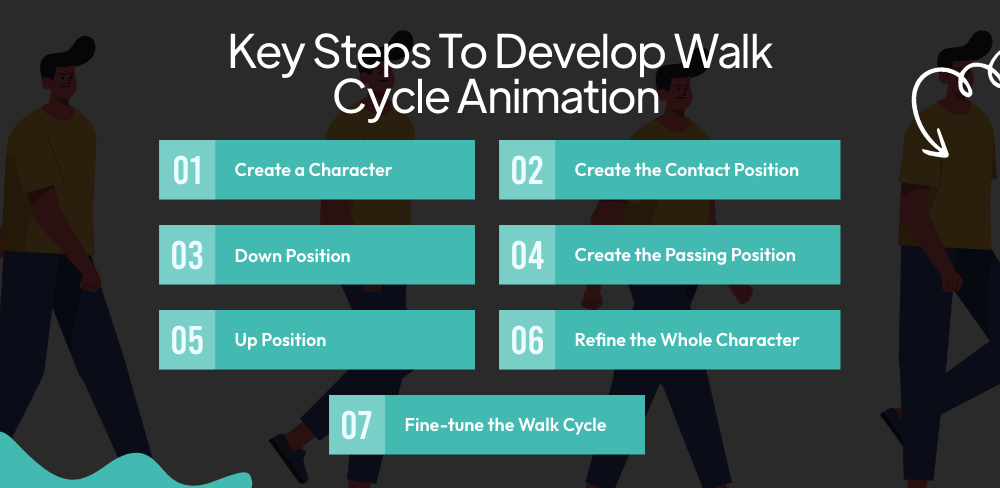“Mastering the walk cycle is the foundation of bringing your characters to life. By understanding the principles of animation, you can breathe believably into every step.”
– Richard Williams
Getting good at making walk cycle animation is not just about being artistic. It is also a smart business move. Entrepreneurs can make their work stand out when they focus on getting those animations just right. That means it increases your business’s possibilities. So, if you are also an entrepreneur and want a lot of success and money in the long run, this blog is for you.
It will explore each and everything that you must to know create a perfect walk cycle animation. It will include character walk cycle development stages, essential features, the cost involved, and many more.
Quick Summary: If you are wondering how to draw a walk cycle, you have reached the right place. This blog will outline the steps, features, and costs of developing human walking cycle.
What is Walk Cycle Animation?
The walk cycle animation is described as a series of illustrations made in a sequence. It shows a picture of a character lacking one after another very fast. When flipped quickly, these images come alive and make the characters look like they are walking. It‘s like a short movie played in a loop that shows the character’s arms and legs moving as they walk.
The animated walk cycle saves time, and the character walks smoothly on screen. In cycle walk animation, simulations are used in a variety of animation practices- 2D, 3D, and many forms of cartoon creation.
Furthermore, nowadays, AI in walk cycle animation is used through advanced algorithms that analyze motion data to generate lifelike movements for characters. As a result, it reduces manual efforts, enhances realism, and speeds up production.
So, if you also want a perfect walk cycle for your business, you must learn the basics to get the best start and have a deep knowledge. However if you are not familiar with all this, you can consult an Artificial intelligence development company for a better outcome.
Market Analysis of Walk Cycle Animation
Size of the animation market worldwide from 2020 to 2030
(in billion U.S. dollars)

Source: Statista
According to the source, the global animation business would be worth more than 391 billion US dollars in 2022, up 5% from 372.4 billion in the previous year. The annual sum was expected to rise over the decade, exceeding 587 billion dollars by 2030.
Why Should Entrepreneurs Invest In Walk Cycle Animation Development?
Walk cycle animation, a significant block of character movement, might seem like a simple detail. However, as per the software development company, for businesses, investing in good-quality cartoon walk cycles can bring major benefits across different industries. Here are a few of the reasons why:
- Improved User Engagement
- Cost-effective Communication
- Scalability and Versatility
- Increased Conversion Rates
- Culture-proofing Your Brand

1. Improved User Engagement
In the current digital landscape, the user attention span is shorter than ever. Hence, with engaging animations, businesses can attract users quickly and keep them hooked. A well-designed walk cycle animation in a mobile application adds a layer of polish and interactivity, keeping users engaged and exploring further.
2. Cost-effective Communication
Building a good quality walk animation cycle can be cost-effective compared to traditional video production. As you know, animation eliminates the requirement of set design, location scouting, and expensive live actors. Furthermore, walk cycle animation can be simply reused and repurposed across different platforms that maximize ROI.
3. Scalability and Versatility
The animation walking cycle offers incredible scalability. It can also be adapted to different atmospheres or characters by adjusting clothes, backgrounds, and colors. As per AI development company, this versatility allows businesses to create a library of animation that can be efficiently integrated into future projects, saving them resources and time.
4. Increased Conversion Rates
As per a study, explainer videos with animation contribute to boosting conversation rates. A believable and smooth walk cycle animation within your explainer video can build trust with viewers. A character that moves naturally and feels more reliable makes viewers more receptive to your messages and more likely to convert.
5. Culture-proofing Your Brand
As you know, the world of animation is continuously changing more than ever, and walk-cycle animation remains a foundational component. As per AI development company investing in a high-quality animation positions your brand for future growth in the current-expanding world of interactive experiences, augmented reality, and virtual reality.
Mohit Nag (Project Manager)
Building a successful walk cycle animation is not an easy task however, with a lot of hard work, my team and I created it. Throughout the animation walk cycle development journey, we have gained valuable insights, and now, we have discovered the easiest way to develop a perfect walking animation cycle. So if you are also looking for the same, get ready to discover the insider tips that I am sharing with you in this blog.
Key Steps to Develop Walk Cycle Animation
Now that you have learned how drawing a walk cycle can benefit your business it’s time to learn how to animate walking cycles for your business. As per art and design app development company, the following key steps of walk cycle animation for beginners is the best way to bring your idea of character walking animation to life.
- Create a Character
- Create the Contact Position
- Down Position
- Create the Passing Position
- Up Position
- Refine the Whole Character
- Fine-tune the Walk Cycle
1. Create a Character
Before your character takes their first animated steps, ensure a solid foundation. Select whatever size you want to upload it to any social media platform. Additionally, design your character, consider their proportions, personality, and style.
Hence, this initial concept will impact the overall feel of your walk cycle. Furthermore, sketch out your different characters, helping you visualize the character’s movement.
2. Create the Contact Position
Now, the walk cycle creation starts with the “contact position.” One foot is planted firmly on the ground to support the character’s weight. This pose establishes the balance and posture of the character. Additionally, you need to pay attention to details like the position of the other leg and weight distribution on the ground.
3. Down Position
In the down position, the entire weight of the character’s body is transferred to the touching foot. It’s the lowest posture of the walk, therefore drop your hips to execute the weight traveling downwards.
On the other hand, to build an app like FlipaClip, you have to ensure that you do not go overboard. It makes it look natural and seem like a human walk in actuality.
4. Create the Passing Position
The passing position describes the dynamic moments in which one leg passes the other. This is a critical stance for attaining a convenient and smooth walk cycle.
The supporting leg is fully stretched behind the torso while the other leg swings forward and prepares to make contact with the ground. The torso and arms help offset the movements that create a sense of propulsion.
5. Up Position
The “up position” follows the passing position. The forward leg makes contact with the ground and becomes the new support. The torso lifts slightly while the opposite leg swings back, preparing for the following downward posture. Hence, this stance completes the cycle that produces the impression of continual movement.
6. Refine the Whole Character
While the legs take center stage during the walk cycle, do not overlook the rest of the character. The torso should try twice and turn with each step, which creates a natural flow. If required you can hire AI developers to ensure that the arms swing in counter-rhythm with the legs, which will improve balance and movement.
7. Fine-tune the Walk Cycle
You can focus on the details once you have the basic structure for the walk cycle down. At this phase, your animation skills genuinely shine. Pay attention to the timing and spacing of stances.
Now, experiment with various speeds and exaggerations to build a walk cycle that reflects your character’s personality. Consider adding details such as head tilts, small foot drags, and minor arm swings for a more realistic and complex movement.
Must-have Features of Walk Cycle Animation
Developing a smooth and convincing walking cycle animation includes a range of key features to make it visually appealing and realistic. Hence, as per the AI app development services providers, you must consider the following key features in your cycle walk animation to attain success:
Balanced Weight Transfer |
Weight for your character convincingly shifts from one leg to the other throughout the cycle. |
| Contrapose | The upper body leans slightly in the opposite direction of the stepping leg for balance. |
| Natural Foot Movement | The foot swings forward with a modest arch, lands heel-first, and rolls to the toes during push-off. |
| Arm Swings | Swing your arms in the opposite direction of your legs to provide rhythm and balance. Elbows blend slightly |
| Looping | The cycle connects the end pose to the beginning for continuous playing. |
| Timing and Spacing | Frames are intentionally placed at a natural walking speed. It involves fewer frames between significant positions |
| Follow Throughout and Anticipation | The subtle motion before and after the main action improves fluidity. |
How Much Does It Cost To Develop Walk Cycle Animation?
The cost to develop a walk cycle animation can differ depending on various factors. If you hire an app development company, the cost of the best animation software can range from $9000 for a basic walk cycle to $30000+ for a detailed animation.
Elements like the number of frames, level of detail, and the expense of the animator can significantly influence the cost. Alternatively, you can create the whole cycle using animation that would only require the software’s cost and your time investment.
Walk Cycle Animation |
Estimated Cost |
Time Frame |
|
Simple Walk Cycle Animation |
$9000 – $14000 | 3 to 6 Months |
|
Medium-Complex Walk Cycle Animation |
$14000 – $21000 | 6 to 9 Months |
|
High-Complex Walk Cycle Animation |
$30000+ | 10+ Months |
Tech Stack For Building a Perfect Walk Cycle
Component |
Technologies |
| Frontend | React Native, Flutter, Swift, Kotlin |
| Backend | Node.js, Python (Django/Flask), Java (Spring Boot) |
| Database | SQLite, MySQL, PostgreSQL, MongoDB, Firebase |
| API Integration | RESTful APIs, GraphQL, SOAP |
| Authentication | OAuth, JWT |
| Push Notifications | Firebase Cloud Messaging, Apple Push Notification Service |
| Analytics | Google Analytics, Firebase Analytics |
| Version Control | Git, GitHub, Bitbucket |
| Deployment | Google Play Store, Apple App Store, TestFlight, Firebase App Distribution |
Wrapping Up!
Building a walk cycle is quite difficult but attainable by following the above mentioned steps. Additionally, developing a perfect walk cycle animation is not just about being creative. It’s also a wise business decision.
By focusing on the little things and working hard to get better at this skill, an entrepreneur can make their projects better, attract people’s attention, and make more money from their animation.
If required you can also take help from an entertainment app development company, having a vast knowledge of technology used in developing a successful cartoon walk.
Frequently Asked Questions
1. How is the Run Cycle Different from the Walk Cycle?
In the run cycle, the back foot has already been raised from the ground when the front finds contact. In contrast, in the walk, the back foot touches the ground.
2. How Long Does It Take To Animate A Walk Cycle?
The time it takes to draw an animation walk cycle depends on various factors, including the complexity of the wall cycle, the designer’s skill level, facial expressions, and more.
3. What Are The Key Elements Of A Walk Cycle Animation?
The key elements include consistent character proportions, proper timing and spacing, natural movements, and attention to details like body mechanics and weight shifts.
4. Can Walk Cycle Animations Be Used In Different Types Of Projects?
Yes, you can use the animation of walking cycle in different projects, including video games, educational videos, cartoons, and advertisements.































